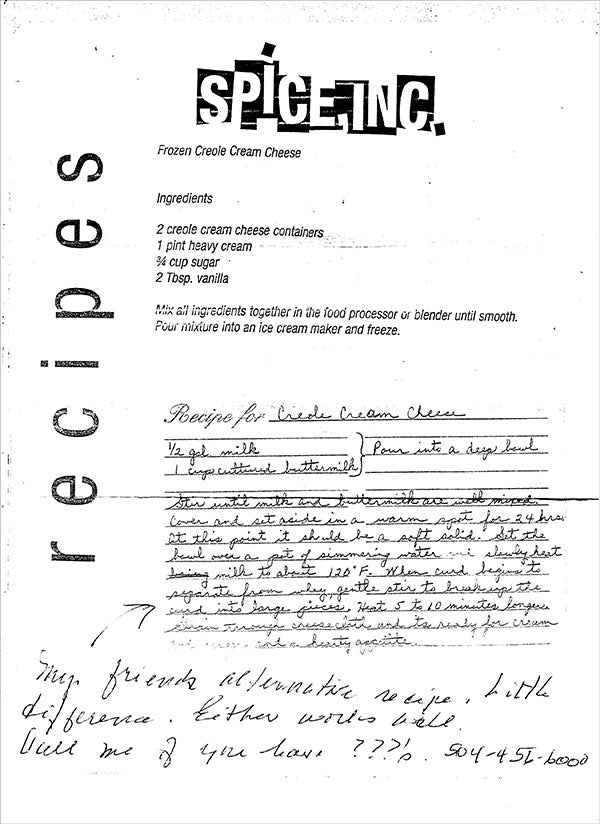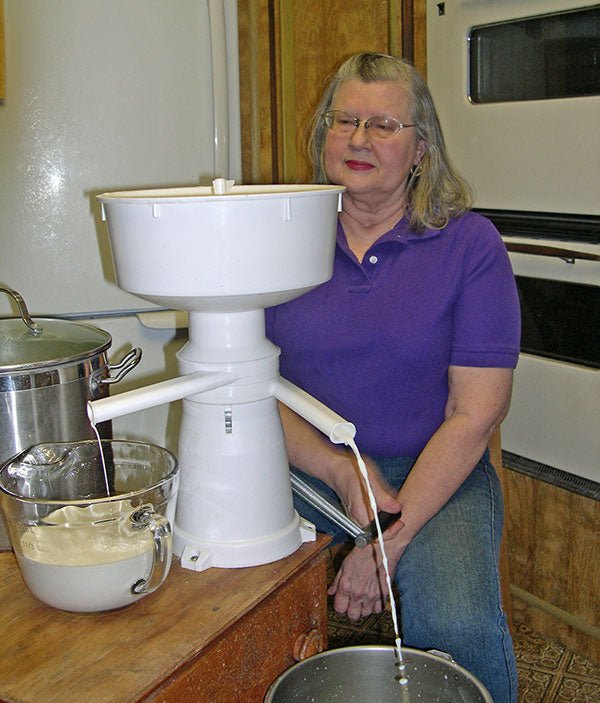 During the 36+ years we have been in business, we have posted many recipes for Creole cream cheese. You will find the most detailed one at our website recipe page – click here. There is also a recipe in our book, Home Cheese Making. The one below is from our original newsletter The Cheesemakers” Journal and Bob Albers submitted his recipe to our blog in 2016 – click here.
During the 36+ years we have been in business, we have posted many recipes for Creole cream cheese. You will find the most detailed one at our website recipe page – click here. There is also a recipe in our book, Home Cheese Making. The one below is from our original newsletter The Cheesemakers” Journal and Bob Albers submitted his recipe to our blog in 2016 – click here.

From our Spring 1997 edition of The Cheesemakers’ Journal
The recipe Bob sent us today came from his wife’s late mother. We’re pretty sure she would have loved that Bob cherishes this recipe and that he shared it with us here.
Creole Cream Cheese the “Old Fashioned” Way
By Bob Albers*
Long long ago, in a much gentler time, lived a woman whom everyone called Memere. The times were so gentle that even politicians called members of the other party “the loyal opposition” instead of some common epithets we hear today.

Her name was Merle Marshall. Among her traits were that of a hospitable hostess and fabulous cook. To the core, she was a warm human being. She was a very wealthy woman. Oh, not in the monetary sense. Actually she had little money. Her wealth was her gentle warmth-her sweetness which she generously bestowed on all around her. Everyone loved her. I am fortunate enough to have married one of her four daughters.
We lost her in 2005. While clearing out her house, I discovered her Creole Cream Cheese molds. This inspired me to make cheese. At first it was only Creole Cream Cheese according to the recipe of Gold Seal Creamery which had been published in the local newspaper. That recipe required rennet and the special molds which we found in her home. It would seem that it was only one of her recipes. (We posted that recipe – click here.)

Just before Christmas 2017, my sister-in-law, Nancy, was rummaging through some old family papers. As she did, she came upon a hand written Creole Cream Cheese recipe in her mother’s hand writing. Knowing that I took her mother’s molds when we cleaned her house after her passing and have been making cheese ever since, she gave me this precious piece of family gold. I read the recipe and it’s notes. The absence of rennet spurred my curiosity and told me that the recipe hearkened back to an earlier time when rennet was not readily available. Also, the process reminded me of my own mother’s reaction to spoiled milk.
Memere’s Recipe
Creole Cream Cheese
Ingredients:
1/2 gallon milk
1 cup cultured buttermilk
Directions:
Pour into a deep bowl and mix together.
Cover and set aside in a warm spot for 24 hours. At this point it should be a soft solid.
Set the bowl over a pot of simmering water and slowly heat the milk to around 120F.
When the curd begins to separate from the whey, gently stir to break up the curd into large pieces.
Heat 5-10 minutes longer.
Drain through cheese cloth and it’s ready for cream and sugar and a hearty appetite.
Frozen Creole Cream Cheese
Supplies:
2 Creole cream cheese containers
Ingredients:
1 pint heavy cream
3/4 cup sugar
2 tablespoons vanilla
Directions:
Mix together all ingredients in a food processor or blender until smooth.
Pour into an ice cream maker and freeze.

In this recipe, the milk is made to “spoil” (acidify) by the addition of cultured buttermilk. In colonial days, there was no refrigeration, so in tropical New Orleans there might have been an abundance of this “spoiled” milk. If left alone, there will be a natural separation of the curd and whey. Creole Cream Cheese is merely the freshly separated curd. Modern methods using buttermilk to inoculate the milk and rennet to aid in the curd separation merely speed up the process. This recipe seems to be a halfway evolution from the original methods to the modern.
As I tried this method using a teflon lined 6 qt. pot, it happened to be one of the colder days. It is started at 8:00 PM on January 2, 2018. The outside temperature was now 40F and it had gotten down to 26F in the early morning hours. Usually, my laundry room is warm enough to do the 24 hour wait. This time, I had to extend the wait time to 32 hours because the laundry room wasn’t warm enough. The mixture of milk and cultured buttermilk barely reached 68F instead of the usual 80F. Even after 32 hours, there certainly wasn’t a clean break in the curd which was more the consistency of a very heavy gelatinous syrup.
I heated the pot of this syrup on the stove to the temperature of 118F in the middle of the curd, 121F at the bottom and 113F near the top.

I let it rest for about 20 minutes. As the curd rested, I could see a clean break develop at the spot where I tested the temperature. Also, the curd mass was separating from the side of the pot. After 20 minutes, I tested for and got a very clean break.

Now it was time to ladle the curd from the pot to my strainer lined with a flour sack towel. I usually use a flower sack towel at this point, as it catches all of the curd only letting the whey pass. It compensates for a weak curd.
I noted that this curd was quite firm and congealed so, in order to encourage faster draining, I raised one end of the towel and gradually lifted it and removed it from the strainer as the curd rolled out of the towel into the strainer. (Sorry that there isn’t a photo of this process as it took 2 hands to gently do the job.) You can see the result here:

Curious as ever, I tasted the curd at this point. It tasted just about the same as the unadorned Creole Cream Cheese using the “Gold Seal Creamery” recipe with rennet – not sour, not sweet, but mild. That recipe is published by Ricki in her book “Home Cheese Making” and also, my slight variation is published in this blog (Creole Cream Cheese with Bob Albers).
After an hour of draining, the constant drip of whey seemed to have stopped. According to the recipe, it was ready to eat. Because of my curiosity concerning the lack of refrigerated whey drainage used with the Gold Seal recipe, I put this up in the serving containers and chilled it for a day to see if there would be more whey separation. (Besides, my wife prefers hers chilled.)

I ate one of the cheeses for breakfast this morning by pouring on some half & half and 2 tsp. of Splenda. The taste was good. It was slightly more piquant than Creole Cream Cheese made with rennet and no cooking of the curd.
You may have noted that my mother-in-law’s recipe was written at the bottom of a recipe for Frozen Cream Cheese. I vaguely remember this from my childhood. The next time I try this recipe, I will then use the product to make the frozen treat.
The yield from this ½ gallon milk recipe was 16.75 ounces. That should be enough for the frozen recipe at the top of my mother-in-law’s recipe.
See you next time.
 *About Bob
*About Bob
Bob is a retired electronics engineer who has traveled all around the world, but now lives in Mandeville, Louisiana. He has written 11 articles for us so far (including this one), and we have done one about him (click here). We’re very grateful to him for his contributions to our community of home cheese makers.
These are his previous articles, listed in order with the most recent at top:
Calculating Weights for the Dutch Style Press
Be a Court Appointed Special Advocate (CASA)
Time Keeping Spreadsheet for Making Cheese
Kummelkase (Caraway Cheese)
Cream Cheese Experiment
Bob’s Homemade Curd Cutter – Part 2
Bob’s Homemade Horizontal Curd Cutter
Making a Drying Box
About Cooking Curds
Creole Cream Cheese














































































































































